

National Archives. DOGO News - Kids news articles on social-studies! Kids current events; plus kids news on science, sports, and more! Fodder for young minds Kids News - Social Studies Articles China Prepares To Welcome The Year Of The Fire Rooster!
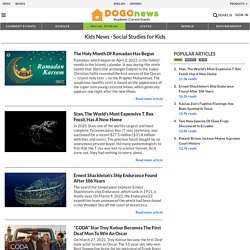
By Meera Dolasia on January 24, 2017 On Saturday, January 28, Chinese communities around the world will begin a two-week celebration to usher in the Chinese New Year. Also called the Spring Festival, the holiday whose dates are determined by the lunar calendar, is the grandest and most famous of all Chinese festivals. Read news article How Social Media Helped Instigate Saturday's Global Women's March. DocsTeach. Welcome to PrimaryAccess. OPB American History Interactive: Analyzing Artifacts - Introduction. This interactive will guide you through the process of analyzing historical artifacts.

You can apply the same methods that historians use to evaluate everyday items—from dishes, to clothing, to weapons. This process allows you to examine an artifact, recognize significant information, and consider what that data can tell you about the past. Historians assess five key aspects of an artifact when studying the past. Balancing Sources. Introduction Historical events are rarely adequately explained from just one point of view.

This interactive experience invites you to examine historical events, consider how they have been portrayed in the past, and create a narrative that considers the various perspectives represented. Here's How It Works: OPB American History Interactive: Thesis. This interactive exercise will guide you through the process of evaluating primary sources in order to develop a thesis.
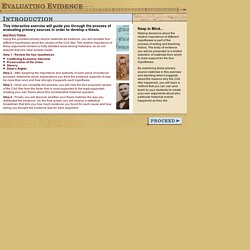
INSTRUCTIONS:Using the provided primary source materials as evidence, you will consider four different hypotheses about the causes of the Civil War. The relative importance of these arguments remains a hotly debated issue among historians, so do not assume that one clear answer exists. Step 1 - Review the four hypotheses Conflicting Economic InterestsPreservation of the UnionSlaveryState's Rights Step 2 - After weighing the importance and authority of each piece of evidence provided, determine which explanations you think the evidence supports (it may be more than one) and how strongly it supports each hypothesis. America's History in the Making — Historical Thinking Skills Interactives. This series of interactive activities introduces and models the Historical Thinking Skills defined by the National Center for History in the Schools.
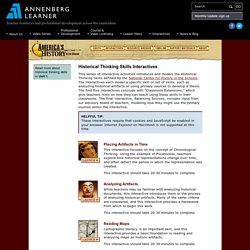
The interactives each model a specific skill or set of skills, such as analyzing historical artifacts or using primary sources to develop a thesis. The first five interactives conclude with "Classroom Extensions," which give teachers hints on how they can teach using these skills in their classrooms. The final interactive, Balancing Sources, includes input from our advisory board of teachers, modeling how they might use the primary sources within the interactive. These interactives require that cookies and JavaScript be enabled in your browser. Internet Explorer on Macintosh is not supported at this time. Launch Placing Artifacts in Time. American Passages - Archive Agreement. Learner.org Legal Policy Please read the following policy and select either "yes" or "no" on this page, indicating whether you agree to accept or decline to accept these terms for using the materials in the American Passages Online Archive.

Do you agree? : This site is owned and operated by the The Annenberg Foundation ("AF") through one of its units, Annenberg Media. The following policies posted on Learner.org, which you ("User") accept by using Learner.org, contain the entire agreement ("Agreement") between you and AF regarding all aspects of your use of Learner.org. Interactive Detail. Teacher resources and professional development across the curriculum Teacher professional development and classroom resources across the curriculum Go Back Print History/Social Studies.

Historical and Cultural Contexts . Intro. Primary Sources on the Web: Finding, Evaluating, Using. This brief guide is designed to help students and researchers find and evaluate primary sources available online.
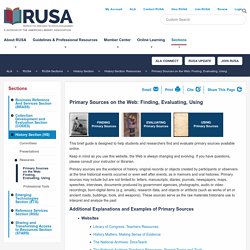
Keep in mind as you use this website, the Web is always changing and evolving. If you have questions, please consult your instructor or librarian. Primary sources are the evidence of history, original records or objects created by participants or observers at the time historical events occurred or even well after events, as in memoirs and oral histories. Primary sources may include but are not limited to: letters, manuscripts, diaries, journals, newspapers, maps, speeches, interviews, documents produced by government agencies, photographs, audio or video recordings, born-digital items (e.g. emails), research data, and objects or artifacts (such as works of art or ancient roads, buildings, tools, and weapons).
These sources serve as the raw materials historians use to interpret and analyze the past. Civil War Primary Sources. Primary Documents by Topic: Most Popular Official Records Addresses & Speeches Acts, Bills, & Orders Military Correspondence & Documents Personal Correspondence & Narratives Prints & Photos Maps Document Collections Getting Started Primary Documents Official Confederate Correspondence Robert E.
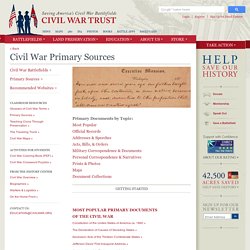
Internet Archive: Digital Library of Free Books, Movies, Music & Wayback Machine. World Digital Library Home. National Archives Experience. American Memory from the Library of Congress - Home Page.
Digital Public Library of America. Featured Exhibits. Featured Exhibits.
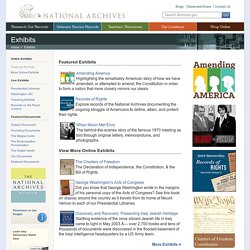
Teachers' Resources. Teacher's Guides and Analysis Tool. Primary Source - Primary Source. Primary Source Sets. Teachers. 10 Ways to Enrich Your Classroom with Primary Sources – Part 1. This is a guest post by Mary J. Johnson, an educational consultant to the Library of Congress. As a teacher, you can saturate your classroom with primary sources from the Library of Congress to promote critical thinking and inquiry. Think of every surface, including computer screens, as potential display spaces for primary sources – photographs, cartoons, music, films, maps, historic newspapers, artifacts, and more. Teaching with the Library of Congress offers timely suggestions. Add questions and critical thinking prompts from the Library’s page for teachers, and you’ll have a constant source of primary source conversation starters at your fingertips.
Carte figurative et approximative représentant pour l’année 1858 les émigrants du globe, les pays dóu ils partent et ceux oú ils arrivent / Part 1 of this two-part post offers ten ideas for filling your classroom environment with primary sources. Teacher Mystery. Library of Congress. Historical Newspapers Online. Discovery Commons. Overture. Newspapers! - The Ancestor Hunt. Chronicling America « Library of Congress. News Archive Search.